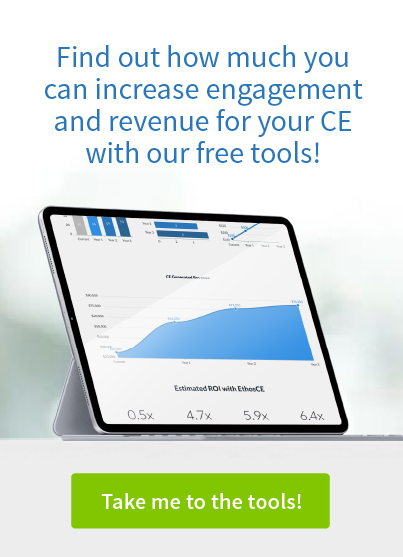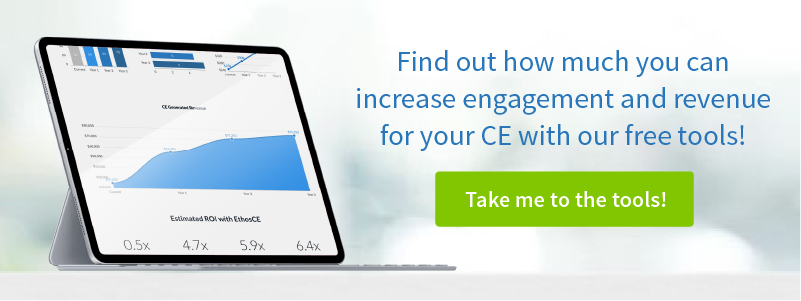3 Ways to Avoid Low-Cost LMS Challenges
Finding a low-cost LMS is like finding a super affordable private plane: it probably won’t take you very far. Have your heart set on a great value? Read on to find out what to look for and avoid when shopping for an enterprise-grade LMS.
Step One: Know the Landscape
As a CE director, you always have an eye on your bottom line. You won’t sacrifice quality for a lower price, but you are willing to take on extra work if it means significant savings for your organization. That’s why you may be considering a low-cost LMS.
Among all of the products that you might find online, a bargain on enterprise LMS software is probably the most unlikely to be a true bargain. That’s because the value of a learning management system is in its original design and enterprise features. IT has been engineered to anticipate the needs of a growing program and help you scale effortlessly.
The kind of robust, intuitive learning management system that you require, with accompanying features and technical support, just can’t be found on the cheap. The good news is that if you find the right enterprise-grade LMS, it will pay for itself by saving you money and ramping up productivity across your entire organization.
Step Two: Know Your Data Management Needs and Refuse to Compromise on Features
Full control over your data is vital to content creation, benchmark assessment, and marketing strategy. Without easy access to program and member data, your decision-making process will be based on guesstimates, not reliable statistics. In a competitive marketplace, data-driven strategy development is the rule, not the exception for CME industry leaders.
If you want to develop content that engages your learners and provides consistently positive educational outcomes, you need actionable insights from all of your program and user data available on demand. If you want your marketing efforts to be guided by what your audience wants, then historical and real-time program feedback and learner inquiry data should be at your fingertips as you develop your marketing strategy.
A low-cost LMS will likely provide limited (if any) data collection tools or analytics services.
With a more powerful enterprise-grade LMS, you will have access to all of your historical and real-time data from a series of customizable data dashboards. You can slice your data the way you want, creating segments to analyze:
- User platform interactivity by region, professional experience, or demographic profile.
- Learner assessment scoring course-by-course or by activity.
- Member engagement with specific activities or pieces of content.
- Learner feedback before, during, and after the course.
- User knowledge retention results after the addition of new content.
These are just some of the data sets that you can analyze with EthosCE Analytics, an analytics suite that can be accessed through the EthosCE LMS.
With EthosCE, your data is drawn directly from the LMS and select external sources. EthosCE Analytics gives you complete control over your data, letting you generate shareable custom reports and elegant data visualizations.
Step Three: Choose an LMS that Enhances Productivity and Reduces Your Administrative Workload
Select an LMS that is an administrative workhorse, reducing the time and resources that your organization devotes to repetitive tasks. A low-cost LMS is unlikely to offer the task automation services that save your team time and protect workflow.
Emails, payment reminders, and member records processing are three of the most time-consuming tasks that tend to become exponentially more burdensome as enrollments increase. An enterprise-grade LMS will take on these tasks for you, freeing your staff to focus on program development.
With task automation, your LMS can handle:
- Learner registration
- Payment processing
- Support-ticket management
- Bulk transcript importing
- User profile creation
- Course credit tallying
- Bulk enrollments
- Certificate of completion delivery
- Course catalog management
- Payment reminders
- Learner updates on course status
- Classroom management
- Assessment scoring and reports
- Member polling and feedback
These are just some of the tasks that automation can manage for you on an enterprise-grade LMS.
On the tech side of things, platform security and software updates are critical to the success of your LMS. This is one aspect of automation that has far-reaching impact well beyond helping your team be more productive.
When something goes wrong with user experience or data security, or your LMS needs a software update, you risk losing students (and your program’s reputation) if you are not able to create a fix quickly.
A low-cost LMS will often leave software update management and platform security to you. That means your members’ data and the security of your website could be left in the hands of a web developer who might not be familiar with your platform, or be unaware of the particular impact of a security issue because it isn’t “their” software.
An enterprise-grade LMS such as EthosCE will provide 24/7 platform monitoring, security patches, and software upgrades. It’s automated so that you never have to touch the tech to know that your LMS is up-to-date and continuously monitored for irregularities. If the need arises for a security patch, it will be automatically installed. That means your team can focus on new ideas, not security issues.
Don’t Settle for a Bargain When You Want Value
EthosCE is an all-in-one platform solution designed to empower organizations of any size to scale their programs seamlessly. We offer you all of the tools you need to maintain peak efficiency from launch, regardless of how fast your program grows.
Ready for the features you deserve? Watch EthosCE in action.
 We're now part of the Cadmium product suite! Learn more
We're now part of the Cadmium product suite! Learn more 


